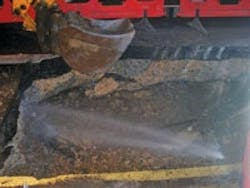About the author: Marc Bracken is vice president and general manager of Echologics. Bracken can be reached at [email protected] or 888.324.6564.
A large industrial facility in the Houston, Texas, area owned by a leading international healthcare, nutrition and innovative materials provider was being plagued by a large water leak in its fire protection system. Water that was being lost through the leak amounted to approximately 50 gal of water per minute and had become apparent, as it was flooding sections of the road running through the facility.
Eventually, the plant was forced to shut down its fire protection system to prevent additional flooding during the week. The service crew dug a 30-ft trench where the location of the leak was suspected.
Shutting down the fire system, even temporarily, compromised the plant’s insurance policy, which specifically required a working fire protection system be in place at all times. Because the facility was essentially operating without insurance while the service crews attempted to locate and repair the leak with little success, the plant began searching for a leak detection solution that could pinpoint the leak without requiring further shutdown of its fire protection system.
Plan of Action
The plant turned to Toronto-based Echologics—a developer of acoustic-based technologies for water loss management, leak detection and pipe condition assessment—for its non-intrusive leak detection expertise and services. The plant was familiar with the technology and its use in industrial water systems across North America and in Europe, South Africa, Singapore and Australia to isolate “silent” leaks that can be hard to detect.
Aging pipelines, inadequate corrosion protection, poorly maintained or outdated valves and mechanical damage are some of the factors that contribute to leakage. Leak detection has historically assumed that most leaks rise to the surface and are visible. In reality, leaks can occur below surface grade for long periods of time, where they remain undetected and continue to lose treated water, which can potentially damage surrounding infrastructure.
Traditionally, acoustic leak detection in industrial water systems is painstakingly difficult: The frequencies and amplitudes created by leaks can be “drowned out” by background noise created by traffic, pumps, engines and other types of machinery that tend to characterize industrial environments. When leak noise frequencies and amplitudes are distorted like this, they can be almost impossible to accurately detect using typical leak noise correlators.
Specialists working on the Houston project used LeakFinderRT, aWindows-based leak detection system that is able to non-invasively detect underground leaks on all pipes—irrespective of their material, pressure, diameter, geometry, etc.
The technology is based on recent acoustical developments that include an enhanced correlation function to dramatically improve its ability to accurately identify and locate narrow-band leak noise that is characteristic of non-ferrous pipe material, low pressures, multiple leak situations and excessive background noise.
Such technologies often are completely non-invasive, which means they can pinpoint leaks without breaking ground, inserting tools into the water system or disrupting service. Traditional leak detection methods typically require excavation or the insertion of hydrophones (water microphones) into the pipe; however, technology that uses enhanced correlators relies on standard pipe appurtenances such as hydrants, valves or direct attachments to the pipe’s outer wall.
Technology in Action
To detect a leak, surface-mounted sensors, or hydrophones, are placed at two locations along the suspect water line—in most cases valves or hydrants—at distaces between 120 and 1,300 meters apart. The correlator compares the acoustic signature of the leak with its expected speed of sound in running water; essentially, acoustic signals are introduced into the pipe by tapping on fittings or releasing water from a fire hydrant. The equipment measures the time it takes for the acoustic signal to reach each sensor. The measured velocity then is calculated by a computer algorithm that, based on the time delay and the sensor spacing, accurately pinpoints the location of the leak.
The acoustic capabilities of this technology meant that the plant was able to turn its fire protection system back on while the engineers non-invasively surveyed the pipe.
Despite the extensive amount of background noise created by the fire protection system’s pumps and other machinery operating throughout the facility, engineers pinpointed the leak’s location in three hours—without breaking ground or inserting any tools into the pipe.
Once the engineers located the leak, the plant’s service crew immediately excavated the site and made necessary repairs that prevented further water loss from threatening the facility’s operations, insurance coverage and water pressure levels of its fire protection system.
Impressed with the accuracy and efficiency with which the leak was non-invasively located, the Houston plant requested follow-up leak detection for the rest of its fire protection system.
Download: Here
